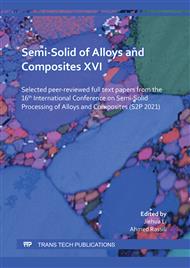p.111
p.119
p.127
p.133
p.140
p.149
p.156
p.163
p.172
Effects of Grain Morphology on Flow Behavior of Semi-Solid Slurries
Abstract:
The flow behavior of semi-solid slurry determines the quality of the castings produced by the semi-solid forming process. Many studies have done to investigate the flow behavior of slurry under different conditions, and results show that the rheological behavior of slurry with dendritic structure is inappropriate for semi-solid forming. In this study, slurries with varying morphologies of grain for the same alloy with the same fraction solid have tested using a partial filling method. The SEED process was employed, and the pouring temperature adjusted to prepare semi-solid slurries with different grain morphologies. The flow pattern, entrapped air during the filling process, and also microstructure of the samples were examined to characterize the macro and micro flow behavior. The results show that a turbulent macro-flow, leading to entrapped air, and severe segregation appeared in the sample using slurry of Tpour ≥ 660 °C . For the slurry of Tpour < 660 °C, none of the three phenomena found in the sample. This investigation further showed that the detriment of dendrite on the semi-solid forming process, and implied that large size dendrite in semi-solid slurry must avoided.
Info:
Periodical:
Pages:
140-145
Citation:
Online since:
January 2022
Authors:
Keywords:
Price:
Сopyright:
© 2022 Trans Tech Publications Ltd. All Rights Reserved
Share:
Citation:


